>>1.Basics and rules >>1.2.Equipment and rules >>1.2.2.Gateball rules(2)(prev|next)
Gateball rules (2) Passing the gate, Agari and continuous stroke
In this section, I'm going to write about passing the gate and finish. Passing the gate is called gate Tsuka and finish is called Agari in Japanese. They are the ONLY two scoring plays in gateball. If stroker's ball make a successful pass through the gate, the stroker will gain the right for a continuous stroke. After you have read through this section, you can calculate the scores of gateball and decide which team wins by yourself.
What happens when your ball passes through a gate?
As the name "gateball" suggests, three gates are very important. As you already know, there are three gates called the first, second and third gate (or simply gate 1, 2, 3) I will explain what happens if a ball passes the gate and what happens if it doesn't.
1. You can't play in the court unless you pass the first gate.After the chief referee announced "Play ball", player 1 tries to pass the first gate (I will call a player who has ball X player X hereafter). Why? That's because you can't play in the court unless you pass the first gate.
The first gate is located 4m from the fourth line and 2m from the first line. The stroker has to set his/her ball in the start area which is a 2m wide rectangle as shown in the figure below. The stroker strikes the ball in the area and if the stroker's ball completely crosses over the line called "gate line", it is regarded as a successful pass. A gate line is defined as the line which connects the back side of the two legs of the gate.
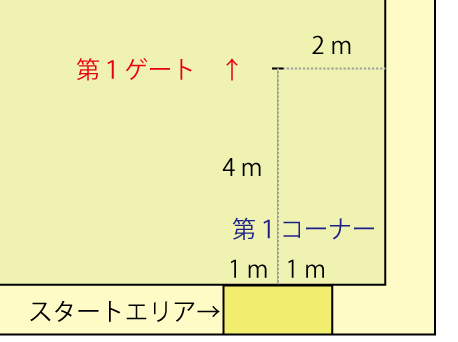
The position of the first gate and the start area
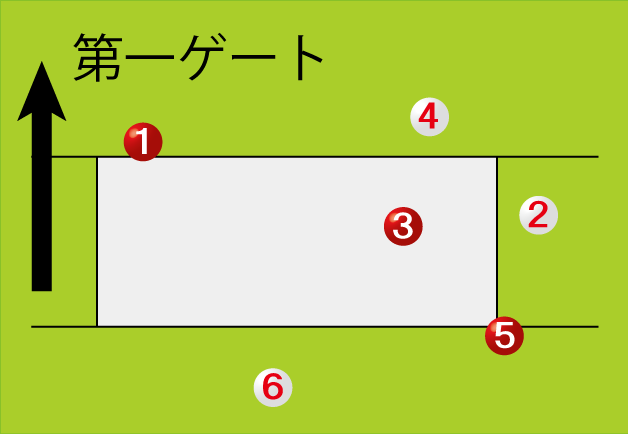
How to put stroker's ball in the start area: The start area (gray) is a two-meter wide rectangle. Players can put their ball anywhere in this area. Most players put their balls on the fourth line where the distance to the first gate is the shortest. In this example, all red balls are rightly put while all white balls are invalid.
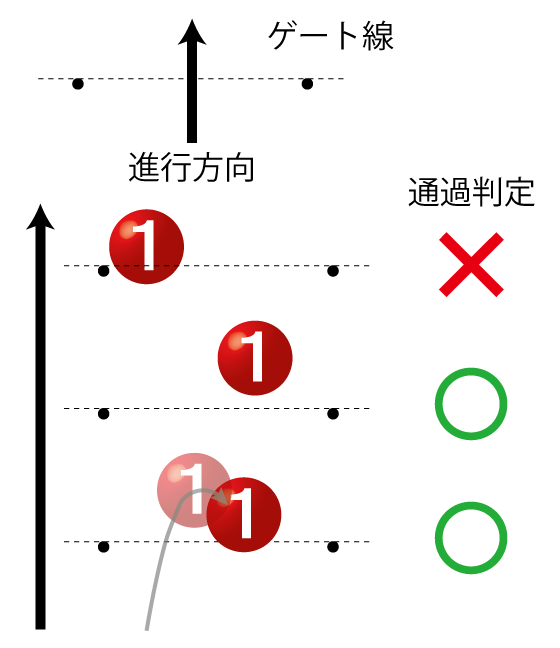
Definition of the gate line:A gate line is an imaginary line which connects both legs (BACKSIDE) of the gate. When a ball completely passes the gate line and one point is gained because of that, it is considered as a successful pass. Three example cases are shown. The outer edge of the ball is on the gate line (top, not passed), the outer edge is off the gate line (middle, passed) and the ball is on the line after completely passing the gate line (bottom, passed). How to judge a successful pass is common for all three gates.
The ball which could not make a successful pass for the first gate is immediately removed from the court. In such cases, the stroker has to try for the first gate again when his/her turn comes next. These challenges continue until the stroker finally passes the first gate. If the stroker cannot make a successful pass within the limited time, the point of that ball will be zero for that game. The first gate is the first and possibly the biggest hurdle for joining the game for beginners.
You cannot pass the first gate with two strokes because the ball which failed to pass the first gate is immediately removed from the court. Obvious!
2. When the stroker makes a successful pass for the 'next' gate, the point of the ball is added by one point and the stroker will get the right for continuous stroke.It is obvious that the stroker's ball will gain one point after passing the gate. I will explain the right for the continuous stroke here. When the stroker's turn comes, he/she will get the right for one stroke. The stroker can move his/her ball with that one stroke such as approaching the gate or your team's friend ball. When nothing happens with that stroke, the stroker's turn will be over because he/she have used up the right for one stroke. However, there are two cases when the stroker can gain the right for continuous stroke. One is when the stroker's ball can make a successful pass for the gate (in other words, when you make your own ball pass the gate and gain one point), the other is when you touch the ball.
One point is added to the stroker's ball immediately after the stroker makes a successful pass. Gateball is a team sport. The team who gained more points will be a winner but each point is not directly added to the team but to each stroker's ball. When the game begins, all balls are zero-point balls. Every time it passes the gate, the point of the ball will change from 0 to 1, 1 to 2, 2 to 3 for the first gate, second gate and third gate, respectively. Each stroker's ball can pass the specific gate only once. Passing the same gate twice or passing the gate from back side is not regarded as successful passes. They are not fouls, though.
The ball which reached the first gate is called a one-point ball. The ball which reached the second gate (i.e. passed the first and second gates) is called two-point ball. The ball which reached the third gate is called a three-point ball as you guess. The ball which passed all three gates (i.e. three-point ball) now can try for goal-pole. Hitting the goal-pole will make the stroker gain additional two points not one. This play is called a finish or Agari (in Japanese). The ball which made a successful Agari is removed from the court. The ball which reached the goal-pole is sometimes called five-point ball or simply Agari ball. Agari balls will no longer come back into the court. It is very important for the captain to consider when to make Agari because the Agari ball is permanently eliminated from the court.
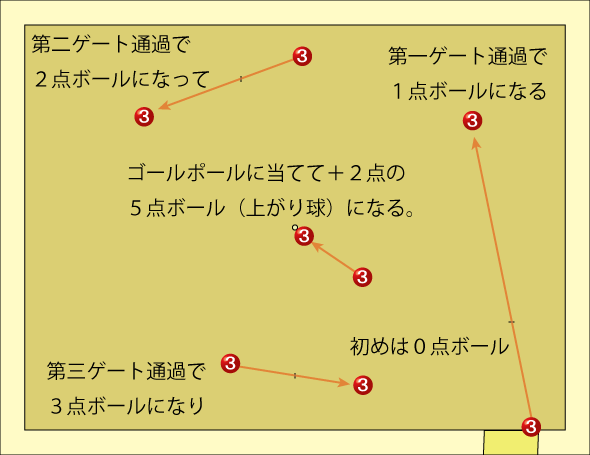
How to gain points:In gateball, every time the stroker's ball passes the next gate, one point is gained. The gates are uni-directional and the strokers cannot skip them. After passing all three gates in the supposed order, those balls can try for Agari to gain two points. The ball which makes a successful Agari will be removed from the court.
Now that you have learned all scoring plays of gateball, you can calculate both teams' points. Each ball has five possible points; 0, 1, 2, 3 and 5. Both teams have 10 balls in total. The number of possible score patterns are 5^10 (I'm not talking about the summed score).
When the point of each red ball is 1, 1, 2, 3, 5, the summed score (i.e. red team's point) is 12 points. When the point of each white ball is 2, 2, 3, 3, 3, the summed points for white team is 13 points. In this case, the white team wins the game with a score of 13 to 12. The points gained by the winner of the perfect game, when one team's all five balls make agari, is 25 points. Simple enough.
Later I am going to talking about what we should do when both teams' scores are tied. It is relatively tough task for the player to keep ten balls' scores while playing. Fortunately, there are some managing devices to keep scores during the game. Did you understand how to calculate the score? Short quiz: can any team gain 24 points as team's points?
 |
1 | 1 | 2 | 3 | 5 | 12 | |
 |
2 | 2 | 3 | 3 | 3 | 13 |
How to calculate scores: In gateball, the gained point is not directly added to the team but added to each ball. After summing all ball's points, the summed points (team's points) are compared. Red ball's point is 1, 1, 2, 3, 5 points, while white ball's point is 2, 2, 3, 3, 3. The summed points are 12 for red 13 for white, thus white wins.
Now let's go back to the continuous stroke. As I explained, when the stroker's ball makes a successful pass, the stroker will gain the right for continuous stroke. To be more precise, the stroker will gain the right for continuous stroke after all balls stop. The stroker's continuous stroke must be done where the STROKER's BALL STOPPED. Keep in mind. This is very IMPORTANT. :If the stroker's ball crosses the boundary of the court, the point for passing the gate is gained but the right for continous stroke is not obtained. If the stroker passes the first gate and in turn passes the second gate with his/her continuous stroke, the stroker will gain the right for continuous stroke again. The right for continuous stroke will be gained until the stroker uses up his/her right for continuous stroke without passing the gate nor touching the balls.
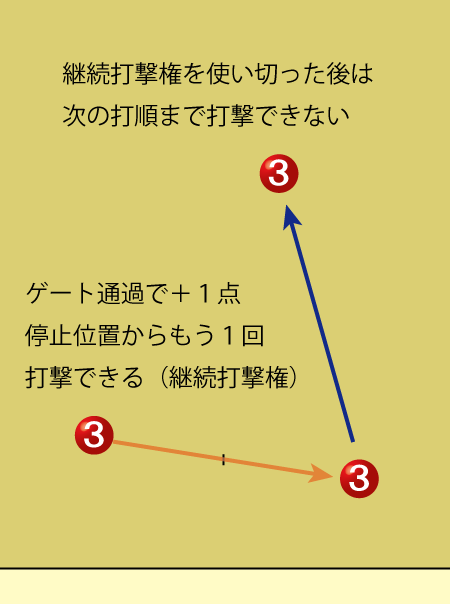
The right for continuous stroke: When the stroker makes a successful pass, the right for continuous stroke will be gained as a bonus. The next play must be done where the stroker's ball stopped.
- Each ball has to pass the first gate to enter the court.
- If failed, the stroker has to wait for the next turn and retry.
- Every time the ball passes the gate in the supposed order, one point is gained.
- When the stroker's ball makes a successful pass, the stroker can strike the ball where it stopped.
- After making Agari, the ball is permanently removed from the court.
